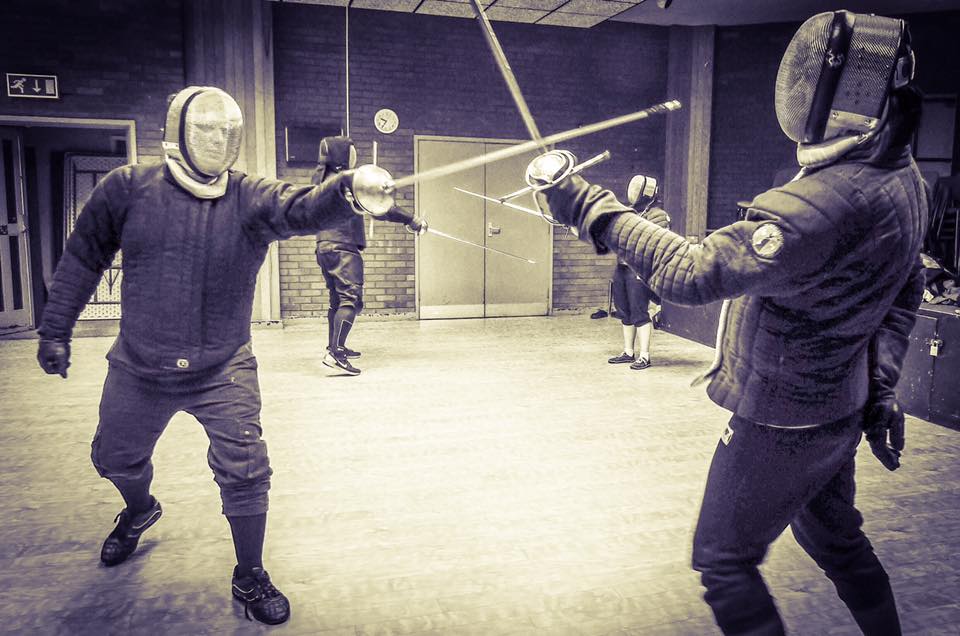“So you do fencing then?”
Sigh. Yes, that question again. How best to explain what I actually do? Let us set a scene. It is important that you, the reader, try to place yourself into the first person view here, and enter this scene. After all it is 2016, and VR is The Next Big Thing. Immerse yourself.
So. You are in a public place, and you realise that the bloke across the room is spoiling for a fight. You get that gut-tightening feeling that comes from knowing that conflict is coming, a rumbling of thunder on the horizon that presages the storm. His mates are egging him on, priming him for the fight.
Oh crap. He’s got a rapier in his hand.
This is not a fantasy foil, a dainty needle languidly waved by some fool in a feathered hat. This is the real thing. A meter of sharpened steel, shaped to a needle point. Not a tool, or a self defence aid, but a murder weapon. This person is coming toward you to murder you. They are going to take that meter of steel and try to shove it through your face, or your throat, or your chest, or your gut. This is happening.
Widen the view. You have a rapier too. Your hand is shaking but you hold it out in front of you, trying to hide behind it, pointing it across the space and screaming inside your head “keep the hell away from me!”. They are still coming, fast. In less than half a second they are going to be in the distance to shove that giant skewer through you.
Tick. Tock. Think quick.
You have two choices. Stand there and be struck, or hit them before they hit you. Stick them with the pointy end. It’s the only way to stop them. They are going to kill you. Tick. Hesitate and you are dead. Tock. Can you really hit your opponent without being hit in turn? Tick. If you can reach them, they can reach you. Tock. Can you move aside?
Tick. Too late.
Widen the view. You’re wearing a fencing mask, and a padded jacket and plastron. The rapier has been blunted, with a rubber stop on the end. The bloke is your friend, and after this bout you are going to call it a day, and go for a pint and talk about technique and historical context and fitness and whether the images in Capo Ferro are intended to be lifelike or a Platonic ideal. Maybe two pints.
Real technique, counterfeit intent, safe (or at least safer) swords. This is HEMA rapier fencing, an attempt to explore or rediscover or recreate the physicality of serious martial practice that has been obsolete for 300 years. We try to find the balance point between safety and fun, and entering the mindset of someone doing something awful in anger or self-defence. This play is a game requiring fitness, speed and stamina, but it’s also a test of intellect, mindfullness and perception.
It is possible to discern historical links between rapier play and modern sport fencing, but the two forms are not comparable, just as the swords in play are definitely not comparable. Measurements varied over the period where something identifiable as a rapier was in use, but you can loosely say that a rapier is a sword optimised for thrusting with a narrow blade a little under a meter long, and weighing around one kilogram. By comparison a modern foil is 90cm, weighing around 350 grams.
HEMA rapier play is not “better” than sports fencing, or vice versa. The two are not meaningfully comparable, as the technique, weapon and context are dramatically different. HEMA is also not re-enactment, or LARP, or theatrical stage combat… but none of this is exclusive. Some of the best HEMA rapier fencers are involved in re-enactment or LARP. The learnings and skills from all these very different contexts can inform and enrich other contexts. We are blind men standing around the elephant that is the historical context of the rapier, doing our best to perceive the whole beast from our disparate positions.

(Photo by David Rawlings, myself on the right fencing left handed with Joseph Sherlock)
